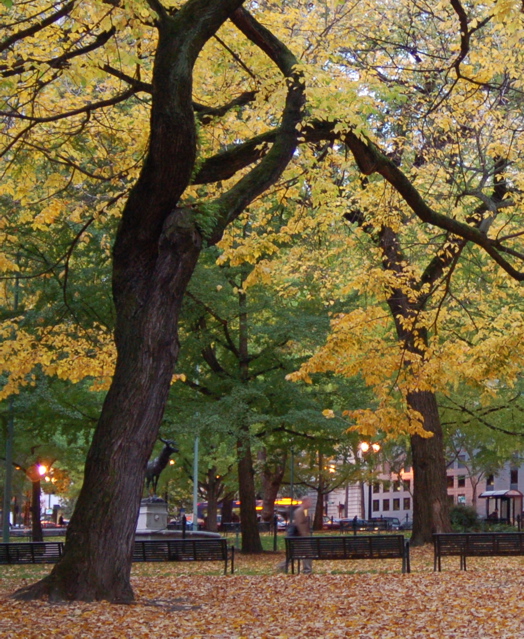
Portland is a city of parks, with quite a few right downtown. I catch the bus that takes me over the Hawthorne Bridge on the way to work every morning here, beside Lownsdale Square Park. Look closely at the tree trunk on the left. See the statue of the elk peaking out? You'll never believe where it is, in relation to Lownsdale Square and its twin to the south, Chapman Square. You can see two more photos I've posted of the elk and its surroundings at Portland (OR) Daily Photo, here and here. To see the photos, click on the first here, take a look, close the window and come on back to there so that you can click on the second here to see the October 27 post. Before you go over to Portland (OR) Daily Photo, why not read some information about this particular park, from Portland Online:
Lownsdale is one of two courthouse squares that comprise the Plaza Blocks which are bounded by Third and Fourth Avenues and Salmon and Madison Streets. The north square is named for Kentuckian Daniel H. Lownsdale, who settled in Portland in 1845 when there were fewer than 800 people living in the city. The south square is named for former Iowa territorial legislator and native Virginian William Williams Chapman (1808-1892) who arrived in Portland in 1850.
The Plaza was a lively place where orators held forth and citizens assembled. They are characterized in part by several large old elms and gingko trees. Chapman Square, originally designed for the exclusive use of women and children, features all female gingko trees. Lownsdale Square was to be the "gentlemen's gathering place." Today the Plaza Blocks are still a busy gathering place, although men and women can now safely coexist in either of them.
In the center of Lownsdale Square stands the Soldiers' Monument, Douglas Tilden’s monument to the Oregonians killed in the Spanish-American War. Dedicated on May 31, 1906, the tall granite obelisk is topped with a bronze replica of an infantryman of the Second Oregon U.S. Volunteer Infantry, part of the first large American fighting force ever sent overseas. At the base of this monument are two small cannons from Fort Sumter (misspelled on the plaque) brought here by Colonel Henry E. Dosch. Because the cannons were used by both Union and Confederate troops, it was Dosch's idea to face one north and one south.
Between the two Plaza Blocks, Main Street curves around a huge elk fountain given to the city by David P. Thompson. Thompson arrived in Portland driving sheep over the Oregon Trail. He served as Portland's mayor from 1879-1882. One day looked out of the office window in his New Market Building at the Skidmore Fountain and decided that he wanted to dedicate a fountain to the city as well. Thompson commissioned Roland Hinton Perry, whose work adorns the Library of Congress and the dome of the Pennsylvania state capitol, and in 1900, he presented the city with a bronze elk fountain to commemorate elk that once grazed nearby. Local architect H.G. Wright designed the stone base of eastern granite, which included drinking troughs for horses and dogs. The Exalted Order of Elks refused to dedicate it because they considered the statue "a monstrosity of art." Many have tried to have Thompson's elk removed because it can be considered a traffic obstacle, but the elk statue remains. In 1974, after a debate about disturbing the blocks in order to complement the then-new General Services Building, Thompson's elk and the Plaza Blocks were designated as Historic Landmarks.
2 comments:
You have some beautiful fall colors! Great shots!
nice pic!!
Greets from belgium
Post a Comment